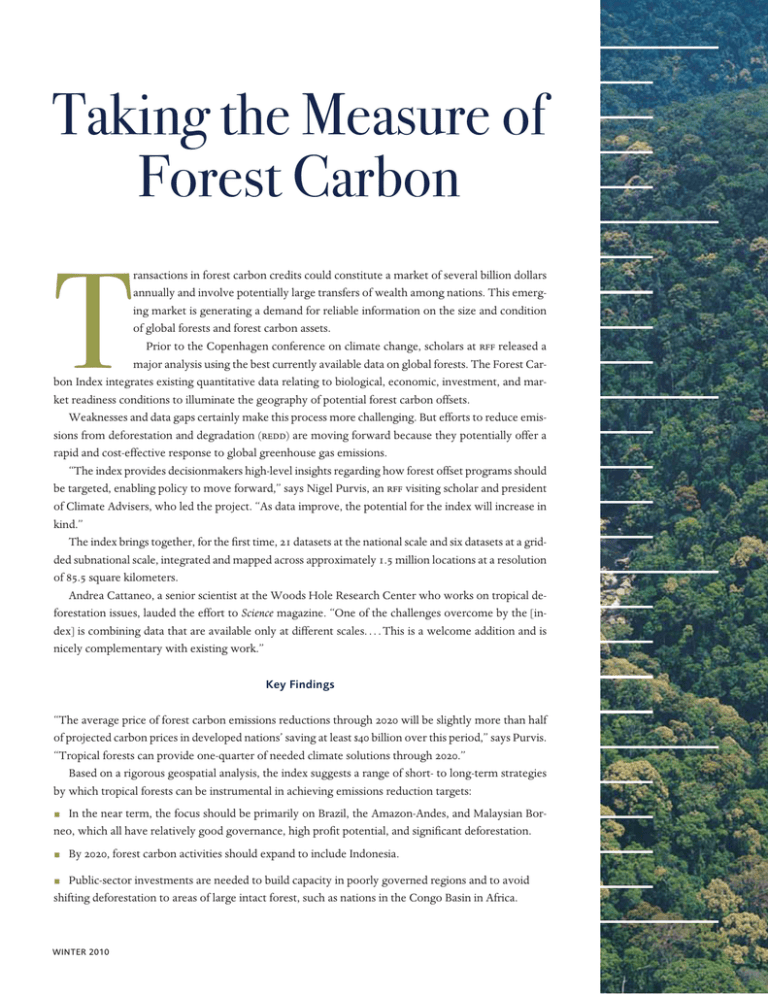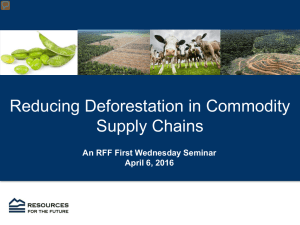T Taking the Measure of Forest Carbon
advertisement

Taking the Measure of Forest Carbon T ransactions in forest carbon credits could constitute a market of several billion dollars annually and involve potentially large transfers of wealth among nations. This emerging market is generating a demand for reliable information on the size and condition of global forests and forest carbon assets. Prior to the Copenhagen conference on climate change, scholars at RFF released a major analysis using the best currently available data on global forests. The Forest Carbon Index integrates existing quantitative data relating to biological, economic, investment, and market readiness conditions to illuminate the geography of potential forest carbon offsets. Weaknesses and data gaps certainly make this process more challenging. But efforts to reduce emissions from deforestation and degradation (REDD) are moving forward because they potentially offer a rapid and cost-effective response to global greenhouse gas emissions. “The index provides decisionmakers high-level insights regarding how forest offset programs should be targeted, enabling policy to move forward,” says Nigel Purvis, an RFF visiting scholar and president of Climate Advisers, who led the project. “As data improve, the potential for the index will increase in kind.” The index brings together, for the first time, 21 datasets at the national scale and six datasets at a gridded subnational scale, integrated and mapped across approximately 1.5 million locations at a resolution of 85.5 square kilometers. Andrea Cattaneo, a senior scientist at the Woods Hole Research Center who works on tropical deforestation issues, lauded the effort to Science magazine. “One of the challenges overcome by the [index] is combining data that are available only at different scales. . . . This is a welcome addition and is nicely complementary with existing work.” Key Findings “The average price of forest carbon emissions reductions through 2020 will be slightly more than half of projected carbon prices in developed nations’ saving at least $40 billion over this period,” says Purvis. “Tropical forests can provide one-quarter of needed climate solutions through 2020.” Based on a rigorous geospatial analysis, the index suggests a range of short- to long-term strategies by which tropical forests can be instrumental in achieving emissions reduction targets: ∫ In the near term, the focus should be primarily on Brazil, the Amazon-Andes, and Malaysian Bor- neo, which all have relatively good governance, high profit potential, and significant deforestation. ∫ By 2020, forest carbon activities should expand to include Indonesia. ∫ Public-sector investments are needed to build capacity in poorly governed regions and to avoid shifting deforestation to areas of large intact forest, such as nations in the Congo Basin in Africa. WINTER 2010 Building Blocks of the Index The Forest Carbon Index combines estimates of a country’s profit potential and risk factors to generate a score of each nation's potential to attract forest carbon investment. The profit potential is calculated by subtracting the expected cost of managing a piece of land for forest carbon from expected forest carbon revenues. The index measures profit potential by looking at biological and economic factors. The index discounts raw profit potential by taking into account the institutional, technical, and political risks within a country. It incorporates widely accepted data from the World Bank about governance conditions (including corruption) and the ease of doing business. (The diagram below displays the framework of the index.) These factors are all combined to create a single index that provides a relative ranking comparing countries and specific locations for their relative capacity to supply forest carbon credits. The results are presented in maps to illustrate the potential geography of forest carbon and in tables to show the estimated costs, quantities, and revenues from forest carbon. ∫ To Learn More You can find the Summary for Policymakers and the full report, Forest Carbon Index: The Geography of Forests in Climate Solutions, at www.forestcarbonindex.org. There, you will also be able to access four interactive maps that allow you evaluate factors like profit potential against location. The index is part of the Forest Carbon Initiative of RFF’s Center for Climate and Electricity Policy, which is funded by contributions from individuals, corporations, government agencies, and foundations. The center received grants from the Doris Duke Charitable Foundation, the David and Lucile Packard Foundation, and the Simons Foundation, as well as a special gift from the Center for Environmental Markets at Goldman Sachs to support the Forest Carbon Initiative. Support for the dissemination of this research was provided by the United Nations Foundation. Forest Carbon Index Forest Carbon Index Framework 6 T T Profit Potential Risk Potential T T T T T Economics Biology Ease of Doing Business Governance Readiness RESOURCES Figure 1. Aboveground Carbon Stocks Figure 2. Country-Level Forest Carbon Index Scores Top: Of the Earth's entire land mass, 85 percent has the potential to be Bottom: The geography of Forest Carbon Index scores at the national level managed for forest carbon. The Earth's soils hold great quantities of shows that tropical countries generally do the best, even after taking carbon, methane, and other greenhouse gases and may have the potential into account risk factors. The Forest Carbon Index also provides highly site- to store even more under the right management conditions. Significant specific local information to guide decisionmaking. uncertainties exist about current soil data. WINTER 2010 7 Figure 3. Best Places for Early Investments at the Local Level Figure 4. Taking Deforestation into Account Top: The Forest Carbon Index predicts how much a country or place will Bottom: This map incorporates existing deforestation rates to better contribute to the global effort to conserve and manage forests to mitigate predict the geography of forest carbon investment in the medium term. climate change by discounting theoretical profit potential by risk. This map Brazil emerges as the best place for forest carbon investments, and highlights the 5 best places in the world for early forest carbon returns. Amazon-Andes countries stand out as well. But Indonesia, as a result of rapid deforestation, moves to second place behind Brazil. Australia has many opportunities to offset its industrial emissions by conserving and growing domestic forests. Countries in West and East Africa with high deforestation rates, from Nigeria and Cameroon to Tanzania and Zambia, also come to the fore. 8 RESOURCES

